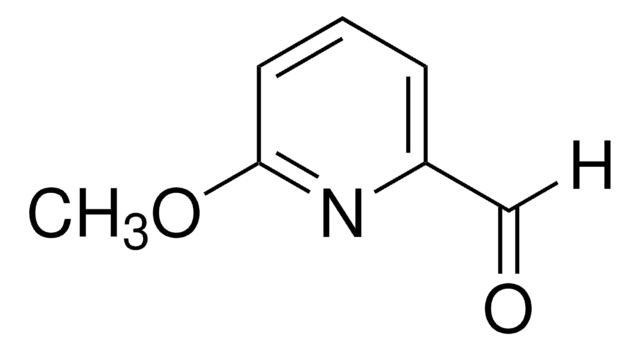P62003
2-Pyridinecarboxaldehyde
99%
Sinónimos:
Picolinaldehyde, Pyridine-2-aldehyde
About This Item
Productos recomendados
Nivel de calidad
Análisis
99%
índice de refracción
n20/D 1.536 (lit.)
bp
181 °C (lit.)
densidad
1.126 g/mL at 25 °C (lit.)
temp. de almacenamiento
2-8°C
cadena SMILES
[H]C(=O)c1ccccn1
InChI
1S/C6H5NO/c8-5-6-3-1-2-4-7-6/h1-5H
Clave InChI
CSDSSGBPEUDDEE-UHFFFAOYSA-N
¿Está buscando productos similares? Visita Guía de comparación de productos
Categorías relacionadas
Aplicación
- To synthesize chitosan based bifunctionalized adsorbent.
- In the aldol addition reaction with pyruvate in the presence of 2-keto-3-deoxy-6-phosphogluconate aldolase (KDPG) catalyst to form (S)-4-hydroxy-2-keto-4-(2′-pyridyl)butyrate.
- In the condensation reaction with (S)-(−)-α-methylbenzylamine and (R)-(+)-α-methylbenzylamine to synthesize two chiral (S)-(−)- and (R)-(+)Schiff base compounds.
It can also be combined with thiosemicarbazide to form 2-pyridinecarboxaldehyde thiosemicarbazone ligand (L) which can further complex with Ni(II) and Cu(II) salts (MX) to form [M(L)2X2] complexes.
Palabra de señalización
Danger
Frases de peligro
Clasificaciones de peligro
Acute Tox. 2 Inhalation - Acute Tox. 4 Oral - Eye Dam. 1 - Skin Corr. 1B - Skin Sens. 1
Código de clase de almacenamiento
6.1A - Combustible acute toxic Cat. 1 and 2 / very toxic hazardous materials
Clase de riesgo para el agua (WGK)
WGK 2
Punto de inflamabilidad (°F)
170.6 °F
Punto de inflamabilidad (°C)
77 °C
Equipo de protección personal
Eyeshields, Faceshields, Gloves, type ABEK (EN14387) respirator filter
Certificados de análisis (COA)
Busque Certificados de análisis (COA) introduciendo el número de lote del producto. Los números de lote se encuentran en la etiqueta del producto después de las palabras «Lot» o «Batch»
¿Ya tiene este producto?
Encuentre la documentación para los productos que ha comprado recientemente en la Biblioteca de documentos.
Los clientes también vieron
Nuestro equipo de científicos tiene experiencia en todas las áreas de investigación: Ciencias de la vida, Ciencia de los materiales, Síntesis química, Cromatografía, Analítica y muchas otras.
Póngase en contacto con el Servicio técnico











